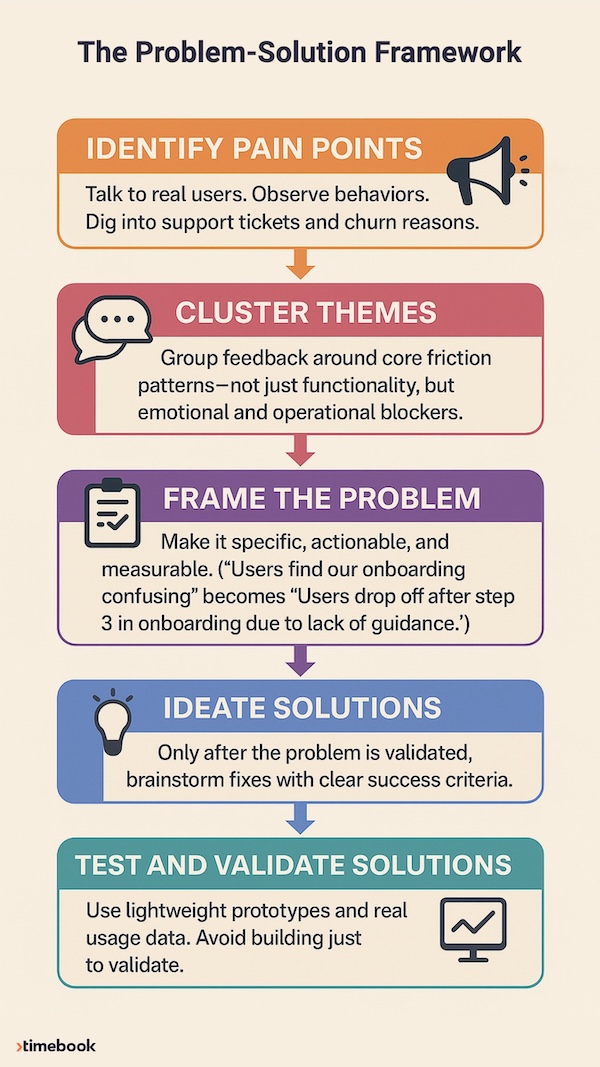A killer problem is high-impact, high-friction, and persistent. Catch them before they become costly
Joe Fields
Product Managers don’t just manage features, they manage risk. And the most insidious kind of risk? Solving the wrong problem. It’s alarmingly easy to get swept up in building without confirming whether the problem you’re tackling is even worth solving. That’s why effective Product Discovery isn’t optional, it’s the difference between building value and burning sprint cycles.
“When you approach product discovery with a detective mindset, it means you’re not waiting for perfect answers. Instead, you’re piecing together insights and learning as you go, and iterating your theory for success.” - David Finnegan
Every roadmap is a bet. When teams commit resources, they’re investing in assumptions: about users, markets, and impact. A feature rooted in misdiagnosed pain points can quietly derail your roadmap. Momentum builds around solutions that feel right but don’t move metrics, or worse, create new complexity.
PMs must act like investigators at the scene of the crime. Before launching epics, they should ask: Are we solving the killer problem, the one causing real damage to our customers and our business?
A killer problem is high-impact, high-friction, and persistent. It blocks customer success, drains internal resources, and undermines strategic goals. Solving it creates disproportionate value, not just functionally, but reputationally. These problems are rarely surface-level. They sit at the intersection of customer pain points and internal inefficiencies.
Here’s the kicker: killer problems don’t scream. They whisper. They masquerade as minor annoyances, misreported feedback, or edge cases until they snowball. Your job as a PM is to catch them before they become costly.
“Fall in love with the problem, not the solution.” — Uri Levine
The Problem-Solution Framework helps product teams break out of reactive building. Instead of jumping to features, you map the problem space first:
This framework doesn’t slow teams down, it optimizes their impact by aligning effort to what matters.

Product Discovery isn’t a phase, it’s a continuous mindset. High-performing PMs don’t “do discovery” once a quarter. They bake it into daily rituals: structured interviews, async surveys, customer council calls. Why? Because product intuition fades fast without fresh inputs.
Discovery should be a feedback flywheel:
🔷 Generate Insights from diverse sources (analytics, voice of customer, win/loss analysis)
🔷 Discover Opportunities that weren't on the radar
🔷 Validate Solutions before scaling
Each loop improves roadmap fidelity. Instead of building by gut or urgency, you’re building by signal.
"The common misconception? Discovery ends when development begins. The truth is, discovery is continuous, and it should happen in parallel with delivery.” - Mauricio Cárdenas
There’s pressure in fast-moving organizations to “just ship.” But quick launches without grounding can lead to feature bloat or rework. Optimizing your roadmap isn’t about speed, it’s about precision. By catching killer problems early, you conserve design cycles, reduce tech debt, and increase customer trust.
You also reduce noise. Not every ask is a need. Discovery helps separate urgent voices from important signals, so stakeholders get what they need, not just what they want.
❌ A feature gets built and usage flops.
❌ Customers keep reporting related issues despite "fixes."
❌ Internal teams circumvent the product with manual workarounds.
❌ Your OKRs stall despite deliverables being completed.
These are symptoms of misalignment between problem and solution. They’re diagnostic clues that it's time to revisit the discovery funnel.
“The best product roadmap is backed by insights, not just gut feelings. It’s been stress-tested for potential risks, aligns with long-term vision, and is adaptable to market changes.” - Nick Gray
Solving killer problems isn’t just about surviving, it’s about positioning. When your product alleviates deep pain, customers feel it. They share it. You differentiate not through features, but through relevance.
The next time a roadmap planning session kicks off, shift the framing: ❌ Don't ask “What can we build?” ✅ Ask “What’s breaking, and what’s the cost of not solving it?”
“The key is to avoid competing on features and/or price. If you focus too much on feature differentiation, then you get into feature wars... When you lack differentiation based on the unique problems solved, your buyers tend to lack justification for decision.” - Joe Allegra
Your roadmap should be a reflection of prioritized value, not a wishlist of nice-to-haves. By embedding discovery and using the Problem-Solution Framework, PMs elevate their craft. They go from feature order-takers to strategy shapers. And most importantly, they stop building things that don’t matter.
Ready to catch the killer problem before it catches up to you?